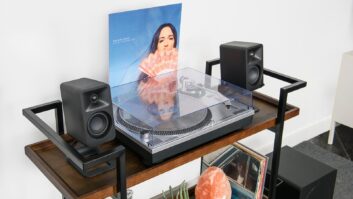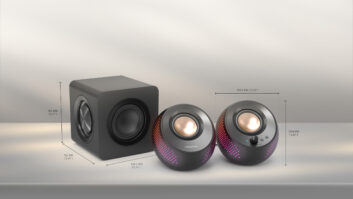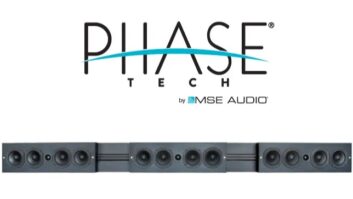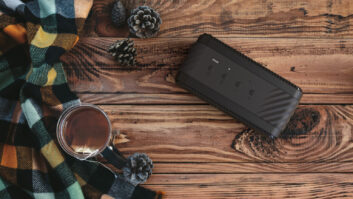Are surround speakers fit to be untied?
Starting in the mid-1990s, wireless speakers gained a measure of popularity as a way to send music to secondary rooms and outdoor patios without running wires all over the place. As home-theater surround-sound speakers, their success was far more limited.
Today, however, wireless speakers could be staging a comeback in the home-theater market. At least four suppliers — Kenwood, Pioneer, Pixa, and Samsung, — have announced plans to offer home-theater-in-a-box (HTiB) systems that use 900MHz or 2.4GHz RF to deliver surround information to the surround speakers. Sony plans to offer at least one system that uses IR to deliver surround-channel information to their respective speakers.
The time for wireless surround speakers is right for several reasons, suppliers said. Enhanced wireless technologies, particularly digital, have combined with more efficient amplification technologies to improved sound quality, reduced size, and lower prices. Perhaps just as important, during the past decade, mass-market consumers have displaced performance-driven early adopters as the majority of home theater buyers, and they’re more willing to trade some level of performance for the convenience of speakers without strings attached.
“The first products [wireless speakers] didn’t deliver the performance for early [home theater] adopters,” Pioneer’s Matt Dever agreed.
Said Claude Frank, Samsung’s digital audio product director, “Ten years ago, the home theater market was all components, not HTiBs, and component customers spent for quality. Wireless was also expensive.”
Indeed, most of the wireless speakers available back then retailed for a suggested $299 to $459, and most used narrow 200kHz-wide channels that helped constrict frequency response that extended out to only about 15kHz, suppliers told TWICE at the time. Better quality came at a substantially higher price. Wireless speakers from JBL boasted near-CD quality but started at about $1,000.
They used 2MHz-wide channels that delivered full frequency response and a signal-to-noise ratio of 90dB at 90 feet. The RF channels’ electrical THD of almost 1 percent, however, kept the systems from delivering all of the clarity and definition of a CD.
For a short time during the 1990s, Sony offered select HTiBs with IR wireless surround speakers, but the company dropped them because consumers were unwilling to pay the premium of about $200 or less, a former Sony executive told TWICE. Competitors also cited the systems’ line-of-sight limitations.
In a system due in September at a targeted everyday $999, however, Sony will return to IR technology to beam 20Hz-20kHz surround information to two $699-suggested tower speakers. Pioneer, in a planned HTiB, will use 2.4GHz wireless RF technology to deliver 20Hz to 20kHz sound to surround speakers. Samsung’s $499 system, with included DVD, uses RF to deliver 20-20kHz audio, though the small surround speakers will limit audible response, the company said.
For its part, Kenwood will use 2MHz-wide channels and 900MHz analog RF to deliver 20-20kHz audio, with 90dB signal-to-noise ratio, to surround speakers in its HTB-S610 system. It’s due in April at a suggested $400 without DVD player.
“Separately available wireless speakers didn’t sell well before, mainly because of quality,” said John Hwang, Kenwood’s product development manager for home entertainment. For the wireless speakers sold as part of its HTiB system, Kenwood adopted multiple technologies to enhance performance and value, he said. One is noise reduction circuitry to reduce RF and AC noise. Another is zero-bit mute circuitry borrowed from the company’s car audio products to automatically mute the amplifier if no surround-channel information is detected. This technology prevents any RF or AC noise from being heard through the surround speakers when no surround information is present, he said.
Kenwood also reduced noise by taking the amplifiers out of the speaker enclosures. Kenwood combines a digital amplifier (rated at 2×50 watt at 1kHz with 10 percent THD) with an RF receiver and power supply in a single 7-by-7.5-by-2-inch module that easily fits under a couch. Standard speaker cables connect the module to each surround speaker. Although speaker wires are needed, he said, the solution eliminates the often-thornier problem of running wires from an HTiB system’s main component to the surround speakers. It also helped Kenwood downsize the surround speakers to match the size and cosmetics of the front speakers, he noted.
The advent of digital amplification is improving the sales potential of wireless speakers, Hwang added, by delivering more output in smaller packages.
To deliver the benefits of wireless speakers to consumers who might not buy its HTiB system, Kenwood will offer it wireless-speaker module separately at a suggested $300 for use with any standard speakers.
Samsung adopted the Kenwood approach in its HT-DS390, due in March at $499 and previously known as the DS490. The system’s receiver/amplifier module is about 12 by 5 by 2 inches.
“Wireless is a lot less expensive now,” Frank said. “Ten years ago, they cost $200 to $300 per pair, and now our whole home theater system with DVD is only $499.” Quality has risen, sizes have shrunk, and wireless speakers are “more desirable” as a result, he said.
The wireless premium, Pioneer’s Dever estimates, has fallen by about 50 percent since the mid 1990s, when digital wireless technology was not used.
Dever attributes the use of digital spread-spectrum technology for the higher performance of wireless speakers in two new Pioneer HTiBs. Pioneer successfully used the technology for the first time last year in a single system whose sales exceeded expectations, he said. It delivers 20Hz-20kHz frequency response, although the single-driver surrounds can’t deliver the full bandwidth, and interference from cordless phones, microwave ovens and wireless networks is minimal, he said.
In its new system, Sony also went digital, but it shunned RF for IR to eliminate the potential for static and interference. Sony said its solution, called DIAT (Digital Infrared Audio Transmission System), transfers digital audio signals without compression and delivers 20Hz-20kHz audio to two active tower surrounds.
To prevent dropouts if someone accidentally blocks an IR signal, Sony relies on redundant systems. An IR transmitter in each of the two front tower speakers transmits left- and right-surround information.
The solution will appear in the fall in at least one Dream System, the DAV-FR1, with four tower speakers, digital amplification and single-disc SACD/DVD-Video player at an everyday $999.
RF and IR technology faces a challenge from powerline-network technology. Pioneer is considering a 2005 launch of speakers that use the Powerline Communications standard developed by the Powerline Communications Group of major CE companies. Pioneer is using the technology to send 32kHz, 16-bit uncompressed linear PCM over powerlines at a 2Mbps data rate to two amplified active tower speakers. The standard allows for a 4Mbps data rate.












